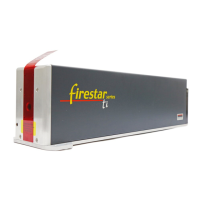maintenance/
troubleshooting
44
Synrad Firestar ti-Series operator’s manual
Maintenance
Debris or contaminants on the laser’s output coupler or external beam delivery components may affect la-
ser processing and lead to damage or failure of the optics and/or the laser. Carefully follow the steps below
to inspect and clean the optical components in the beam path. Before beginning the cleaning process,
read this entire section thoroughly to ensure that all cleaning materials are available and that each step is
completely understood.
Important Note: Exercise great care when handling infrared optics; they are much more fragile than
common glass materials. Optical surfaces and coatings are easily damaged by rough
handling and improper cleaning methods.
Cleaning guidelines
■ Wear rubber or latex finger cots or rubber gloves (powder-free) to prevent contamination of optical
surfaces by dirt and skin oils.
■ Never handle optics with tools; always use gloved hands or fingers.
■ Hold optics by the outer edge; never touch the coated surface.
■ Always place optics on lens tissue for protection; never place optics on hard or rough surfaces.
■ It may be necessary to use a fluffed cotton swab or cotton ball instead of a lens wipe to uniformly clean
the entire surface of small-diameter mounted optics.
■ Before using cleaning agents, read Material Safety Data Sheets (MSDS) and observe all necessary
safety precautions.
Required cleaning materials
Table 4-1 lists the type and grade of materials required to properly clean optical surfaces.
Table 4-1 Required cleaning materials
Cleaning Material Requirements
Finger cots or rubber gloves Powder free
Air bulb Clean air bulb
Ethyl alcohol Spectroscopic or reagent grade
Acetone Spectroscopic or reagent grade
Lens wipe (preferred) Optical (cleanroom) quality
Cotton balls or cotton swabs High-quality surgical cotton/high-quality paper-bodied

